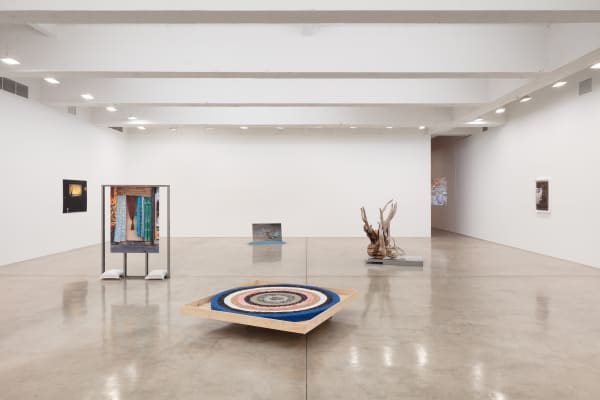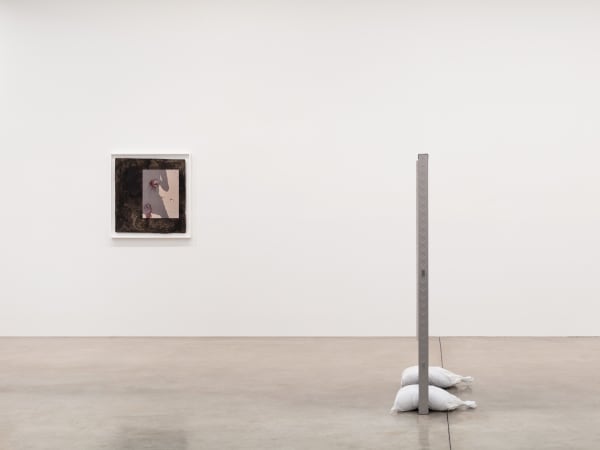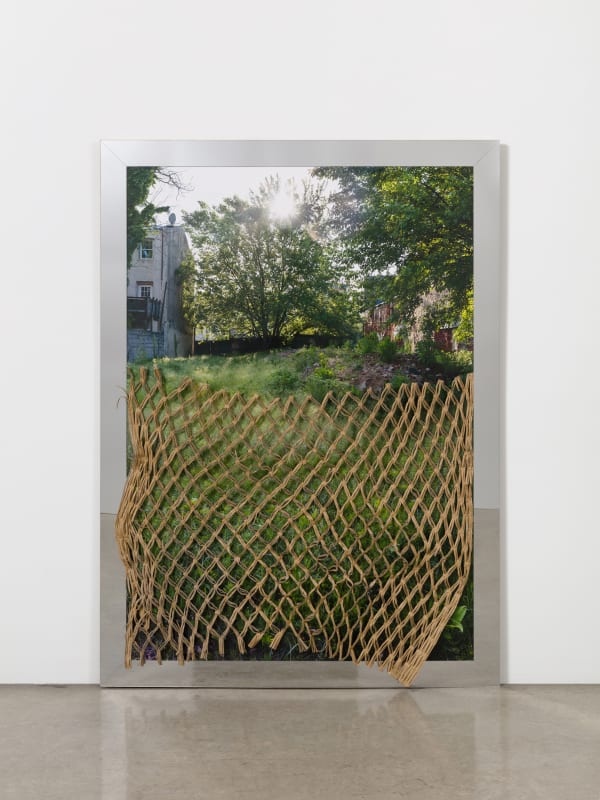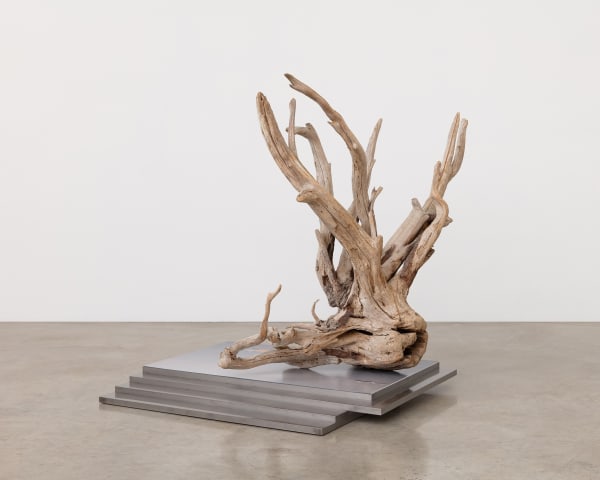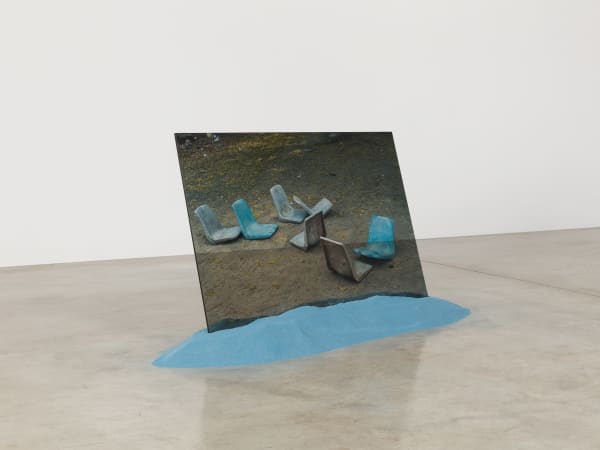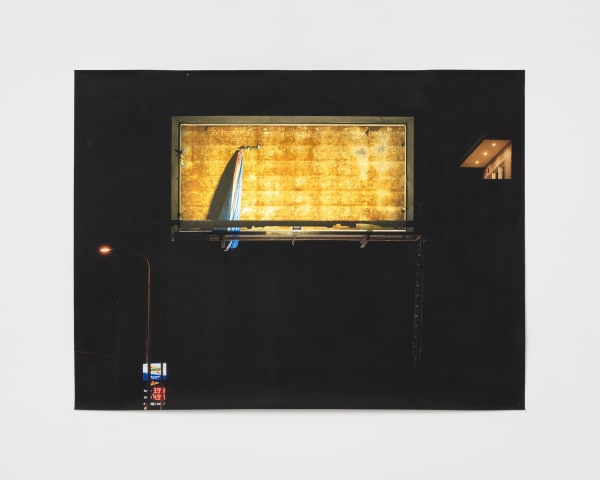展览现场
新闻稿
Tanya Bonakdar Gallery is pleased to present Karyn Olivier: How A Home Is Made, the artist’s second solo exhibition with the gallery, on view in New York from June 22 - July 28, 2023.
Karyn Olivier’s artistic practice merges multiple histories and collective memory with present-day narratives. Through the manipulation of familiar objects and spaces, the artist re-contextualizes the viewer’s relationship to the ordinary. Questioning what we presume to be the function or facts of an object or space, she asks us to reconcile the immediate with the remembered.
In How A Home Is Made Olivier explores themes of displacement, migration, and absence using discarded items and common construction materials. Combining these with photographic imagery, Olivier asks the viewer to reflect on building practices, excess consumption, and Western ideas of progress in late capitalist societies.
Driftwood, Door, Man, and Boat (Gorée Island/Matinicus Island) acts as a work of chronostratigraphy. A large piece of driftwood Olivier recovered from Maine is juxtaposed with an image she photographed from the Door of No Return at the House of Slaves in Senegal. It evokes the complexities of layered time: the weathered driftwood that wears its history and travel, the captured moment of a photo taken 13 years ago, the historical magnitude of the site, and even this current moment—as the loop is closed by the viewer in the gallery today, bearing witness to a fraught and troubled legacy.
In Grief and Loss (AZ Family Discount), an image of sample curtains displayed outside a discount home goods store in Olivier’s neighborhood in Philadelphia, is printed on drywall, attached to metal wall studs, and secured by sandbags. Curtains, which began as functional protection from the elements (serving as walls that kept out the weather), evolved over time as coveted decorative objects that conveyed notions of privacy, ownership, wealth and status. This work points to a purpose beyond necessity, a universal desire to make our homes “beautiful” that transcends economic circumstances.
Powers of 10 (Home kit), which references the Charles and Ray Eames film, displays the materials most frequently used in home construction in ten concentric rings. Positioned above the floor on a custom moveable dolly, the aggregate materials in this “kit” can be understood as a portal into geological time and our current epoch, the Anthropocene, which is defined by humankind’s impact on the planet.
In the back gallery, the viewer is confronted with a wall of orange construction water-barriers, objects commonly found in single lines on city streets. Sampling (Need You) is an installation that incorporates discarded barriers, emptied of water and fitted with audio amplifiers that play sounds Olivier recorded at construction zones throughout Philadelphia. The soundscapes move from barrier to barrier, building site to building site, memorializing the continuous destruction, rebuilding, and expansion happening in cities across the US, while piecing together a portrait of one city in flux. On the adjacent wall is Drift, a video projection of a conveyor belt carrying construction debris, endlessly scrolling onward and out of the frame, like a flowing river.
Olivier recently completed a two-year residency at RAIR (Recycled Artist in Residency),* which was a major inspiration for How A Home Is Made. The residencyallowed her to continue her exploration of the processing and repurposing of materials, and to conjure new objects with reimagined functions, meanings and futures.
Born in Trinidad and Tobago in 1968, and raised in the United States, Olivier received an M.F.A from Cranbrook Academy of Art and a B.A. at Dartmouth College. She completed the RAIR (Recycled Artists in Residency) Fellowship Residency in 2023. She has been the recipient of the Rome Prize (2018), the New York Foundation for the Arts Award (2011), the William H. Johnson Prize (2010), the John Simon Guggenheim Memorial Foundation Fellowship (2007), the Joan Mitchell Foundation Award (2007), and the Louis Comfort Tiffany Foundation Biennial Award (2003).
Important solo exhibitions include Everything That’s Alive Moves at Institute of Contemporary Art in Philadelphia (2020), which traveled to University of Buffalo Art Gallery, and A Closer Look at Laumeier Sculpture Park in St. Louis (2007). The artist’s work was featured in the Busan Biennial, Korea (2006) and Gwangju Biennial, Korea (2008). Olivier’s work has also been included in notable group exhibitions at Documenta 15, Kassel (2022), ICA Boston Watershed (2022); Parrish Art Museum, NY (2022); Ulrich Museum of Art (2013); World Festival of Black Arts and Cultures in Dakar, Senegal (2010); Contemporary Arts Museum, Houston (2007); Whitney Museum of Art, NY (2006); Studio Museum in Harlem, NY (2005); MoMA P.S.1, NY (2005); Museum of Fine Arts, Houston (2004); SculptureCenter, NY (2004), and Mattress Factory (2006), among others.
Olivier has a long career of working in the realm of public art. In 2022, the artist unveiled a major permanent commission entitled Approach at the Newark Liberty International Airport. In 2018, a permanent commission at the University of Kentucky entitled Witness re-contextualized a fraught historical artwork on the university’s campus. The previous year, Olivier completed a large-scale commissioned work, The Battle is Joined, for Monument Lab and Mural Arts in historic Vernon Park, Philadelphia. In 2015, she created a site-specific work in New York City’s Central Park for the Creative Time exhibition Drifting in Daylight, as well as a permanent sculpture for Long Island City’s Hunter Point South Park entitled Tetherball Monument, sponsored by NYC’s Percent for Art program. An artist engaged with creating new models for public art and monuments, Olivier is currently completing two permanent memorials in Philadelphia: at Bethel Burying Ground, a nineteenth-century African American cemetery; and at Stenton House, in commemoration of a heroic eighteenth-century former slave named Dinah.
Karyn Olivier’s work can be found in the permanent collections of Museum of Fine Arts, Houston and The Studio Museum of Harlem.
Karyn Olivier’s artistic practice merges multiple histories and collective memory with present-day narratives. Through the manipulation of familiar objects and spaces, the artist re-contextualizes the viewer’s relationship to the ordinary. Questioning what we presume to be the function or facts of an object or space, she asks us to reconcile the immediate with the remembered.
In How A Home Is Made Olivier explores themes of displacement, migration, and absence using discarded items and common construction materials. Combining these with photographic imagery, Olivier asks the viewer to reflect on building practices, excess consumption, and Western ideas of progress in late capitalist societies.
Driftwood, Door, Man, and Boat (Gorée Island/Matinicus Island) acts as a work of chronostratigraphy. A large piece of driftwood Olivier recovered from Maine is juxtaposed with an image she photographed from the Door of No Return at the House of Slaves in Senegal. It evokes the complexities of layered time: the weathered driftwood that wears its history and travel, the captured moment of a photo taken 13 years ago, the historical magnitude of the site, and even this current moment—as the loop is closed by the viewer in the gallery today, bearing witness to a fraught and troubled legacy.
In Grief and Loss (AZ Family Discount), an image of sample curtains displayed outside a discount home goods store in Olivier’s neighborhood in Philadelphia, is printed on drywall, attached to metal wall studs, and secured by sandbags. Curtains, which began as functional protection from the elements (serving as walls that kept out the weather), evolved over time as coveted decorative objects that conveyed notions of privacy, ownership, wealth and status. This work points to a purpose beyond necessity, a universal desire to make our homes “beautiful” that transcends economic circumstances.
Powers of 10 (Home kit), which references the Charles and Ray Eames film, displays the materials most frequently used in home construction in ten concentric rings. Positioned above the floor on a custom moveable dolly, the aggregate materials in this “kit” can be understood as a portal into geological time and our current epoch, the Anthropocene, which is defined by humankind’s impact on the planet.
In the back gallery, the viewer is confronted with a wall of orange construction water-barriers, objects commonly found in single lines on city streets. Sampling (Need You) is an installation that incorporates discarded barriers, emptied of water and fitted with audio amplifiers that play sounds Olivier recorded at construction zones throughout Philadelphia. The soundscapes move from barrier to barrier, building site to building site, memorializing the continuous destruction, rebuilding, and expansion happening in cities across the US, while piecing together a portrait of one city in flux. On the adjacent wall is Drift, a video projection of a conveyor belt carrying construction debris, endlessly scrolling onward and out of the frame, like a flowing river.
Olivier recently completed a two-year residency at RAIR (Recycled Artist in Residency),* which was a major inspiration for How A Home Is Made. The residencyallowed her to continue her exploration of the processing and repurposing of materials, and to conjure new objects with reimagined functions, meanings and futures.
Born in Trinidad and Tobago in 1968, and raised in the United States, Olivier received an M.F.A from Cranbrook Academy of Art and a B.A. at Dartmouth College. She completed the RAIR (Recycled Artists in Residency) Fellowship Residency in 2023. She has been the recipient of the Rome Prize (2018), the New York Foundation for the Arts Award (2011), the William H. Johnson Prize (2010), the John Simon Guggenheim Memorial Foundation Fellowship (2007), the Joan Mitchell Foundation Award (2007), and the Louis Comfort Tiffany Foundation Biennial Award (2003).
Important solo exhibitions include Everything That’s Alive Moves at Institute of Contemporary Art in Philadelphia (2020), which traveled to University of Buffalo Art Gallery, and A Closer Look at Laumeier Sculpture Park in St. Louis (2007). The artist’s work was featured in the Busan Biennial, Korea (2006) and Gwangju Biennial, Korea (2008). Olivier’s work has also been included in notable group exhibitions at Documenta 15, Kassel (2022), ICA Boston Watershed (2022); Parrish Art Museum, NY (2022); Ulrich Museum of Art (2013); World Festival of Black Arts and Cultures in Dakar, Senegal (2010); Contemporary Arts Museum, Houston (2007); Whitney Museum of Art, NY (2006); Studio Museum in Harlem, NY (2005); MoMA P.S.1, NY (2005); Museum of Fine Arts, Houston (2004); SculptureCenter, NY (2004), and Mattress Factory (2006), among others.
Olivier has a long career of working in the realm of public art. In 2022, the artist unveiled a major permanent commission entitled Approach at the Newark Liberty International Airport. In 2018, a permanent commission at the University of Kentucky entitled Witness re-contextualized a fraught historical artwork on the university’s campus. The previous year, Olivier completed a large-scale commissioned work, The Battle is Joined, for Monument Lab and Mural Arts in historic Vernon Park, Philadelphia. In 2015, she created a site-specific work in New York City’s Central Park for the Creative Time exhibition Drifting in Daylight, as well as a permanent sculpture for Long Island City’s Hunter Point South Park entitled Tetherball Monument, sponsored by NYC’s Percent for Art program. An artist engaged with creating new models for public art and monuments, Olivier is currently completing two permanent memorials in Philadelphia: at Bethel Burying Ground, a nineteenth-century African American cemetery; and at Stenton House, in commemoration of a heroic eighteenth-century former slave named Dinah.
Karyn Olivier’s work can be found in the permanent collections of Museum of Fine Arts, Houston and The Studio Museum of Harlem.
*RAIR is a non-profit arts organization uniquely situated within a construction and demolition recycling center in Northeast Philadelphia. It offers artists studio space, support and access to more than 550 tons of materials per day. RAIR’s mission is to challenge the perception of waste culture by providing a unique platform for artists at the intersection of art and industry. RAIR’s fellowship was made possible by funding from the Andy Warhol foundation for the fine arts, the Virginia A. Groot foundation and a grant from the Edna W. Andrade Fund.
All installation images above: Photo by Pierre Le Hors
作品
-
 Karyn Olivier, For Sale (1510 N. American Street), 2023
Karyn Olivier, For Sale (1510 N. American Street), 2023 -
 Karyn Olivier, Driftwood, Door, Man, and Boat (Gorée Island/Matinicus Island), 2023
Karyn Olivier, Driftwood, Door, Man, and Boat (Gorée Island/Matinicus Island), 2023 -
 Karyn Olivier, Grief and Loss (AZ Family Discount), 2023
Karyn Olivier, Grief and Loss (AZ Family Discount), 2023 -
 Karyn Olivier, (Dis)(Re)(In)place, 2023
Karyn Olivier, (Dis)(Re)(In)place, 2023 -
 Karyn Olivier, Powers of Ten (Home Kit), 2023
Karyn Olivier, Powers of Ten (Home Kit), 2023 -
 Karyn Olivier, Armour (For Martine, St. Elizabeth), 2023
Karyn Olivier, Armour (For Martine, St. Elizabeth), 2023 -
 Karyn Olivier, Flush Flow Stop, 2023
Karyn Olivier, Flush Flow Stop, 2023 -
 Karyn Olivier, Lighthouse (Rite Aid, 6201 Germantown Ave.), 2023
Karyn Olivier, Lighthouse (Rite Aid, 6201 Germantown Ave.), 2023 -
 Karyn Olivier, Welcome (Accra), 2023
Karyn Olivier, Welcome (Accra), 2023 -
 Karyn Olivier, Sampling (Need You), 2023
Karyn Olivier, Sampling (Need You), 2023 -
 Karyn Olivier, Drift (Tributary), 2023
Karyn Olivier, Drift (Tributary), 2023
